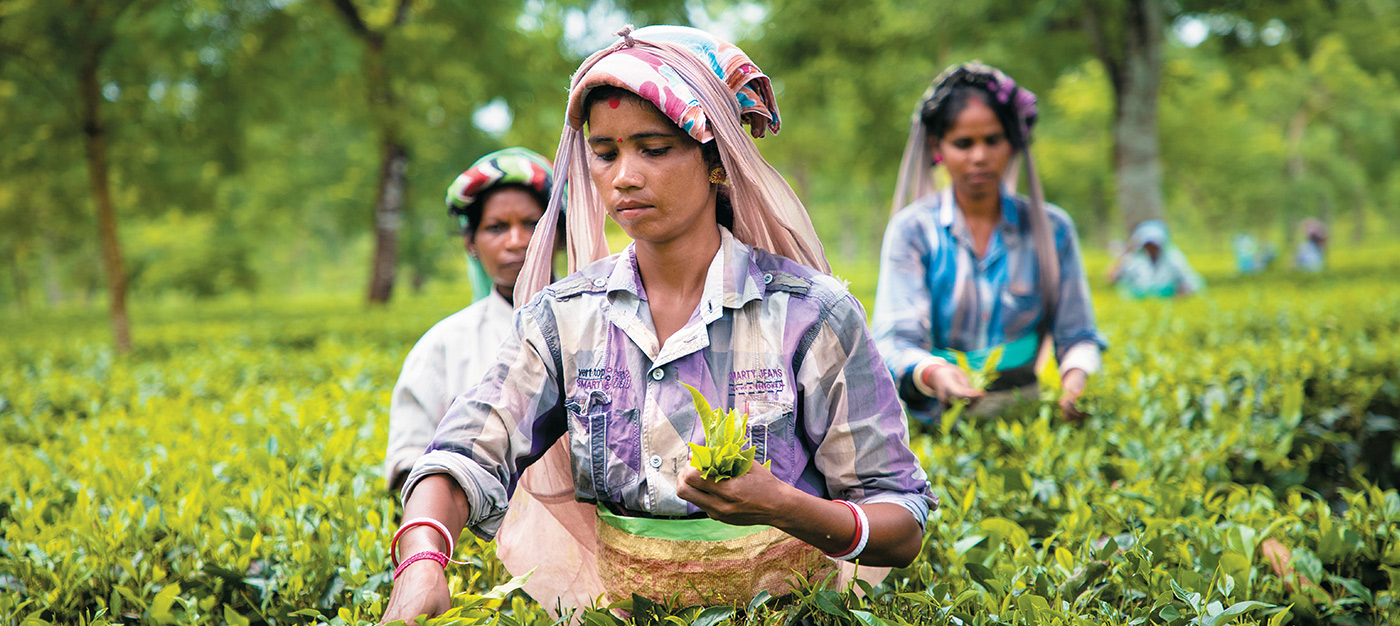
The Green Gold Bond
Tea Board India
Integrating technology for a better
experience, Tea Board India lays emphasis on quality upgradation,
enhancement of exports and improving the efficiency and transparency of the
e-auction system
Among the largest producers of tea in the world,
India achieved commendable tea export figures—254.50 million kgs—during the
financial year 2018-19. India also happens to be the largest consumer of black
tea in the world. Tea is mainly grown in the states of Assam, West Bengal,
Himachal Pradesh, Sikkim, Tamil Nadu, Kerala and Karnataka. Darjeeling tea is
one of the most coveted beverages the world over; tea aficionados also love the
strong, earthy, malty flavour of Assam’s black tea, while Kangra’s green tea has
now proved to be a niche product. From the Nilgiris are emerging some
handcrafted speciality teas. And the Tea Board plays a crucial role in policies,
regulations, licensing, exports and smoothening all other aspects of the trade.
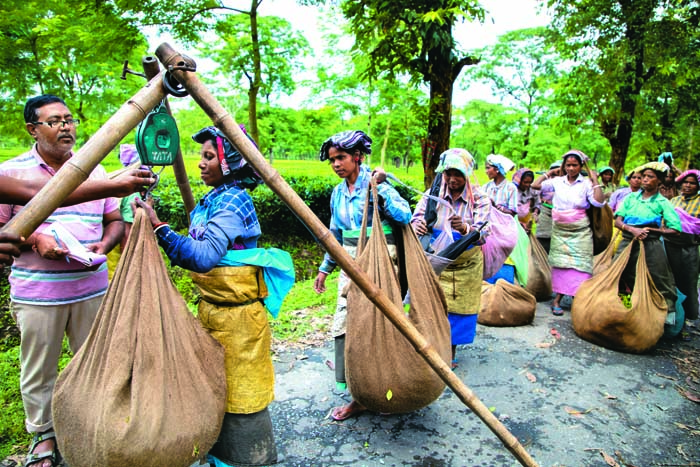
plucked leaves are weighed every few hours
Its genesis goes back to 1903, when the
Indian Tea Cess Bill was passed. The present Tea Board, set up under Section
4 of the Tea Act 1953, was constituted on April 1, 1954. Since then, the
autonomous body has been working towards its mission to “develop effective
management strategies to facilitate competence and innovation in tea
plantations, innovative processing technology for producing good quality
teas,augmentation of high value tea exports, capacity building for human
resources at all levels in tea industry, strengthening of R & D efforts on
all aspects of tea husbandry and technology”.
History traces the roots of
this popular beverage to 1820 in India with the British East India Company
establishing tea gardens and making this a profitable industry. With global
markets vying for this healthy drink, the industry has evolved due to
technology and changing consumer demands.
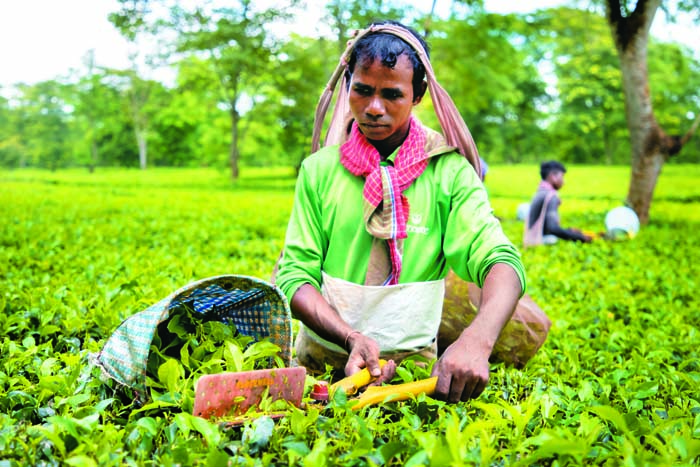
A worker uses shears to pluck tea at the Danguajhar Tea Estate of the Goodricke Group in Jalpaiguri
As the number of growers increased,
policies evolved. Going the digital route, a licensing portal is in place
and e-return submissions are encouraged. Growers have easy access to the
markets, pricing and trends through 'Chai Sahyog' app. There are regular
capacity building programmes such as training, meetings, study tours and
skill development. Plants and nursery assistance are given at a subsidised
cost. Self Help Groups (SHG) are encouraged. Small Tea Growers (STGs) are
supported with common facilities such as green leaf shed, carriage vehicles,
mechanised aids, working capital and revolving corpus.
Palampur in Kangra
even has a state co-operative factory that is a boon for STGs in Himachal
Pradesh. The plan to revive dormant co-operative factories is also on.
There are special schemes such as SCSP and TASP for SC/ST STGs. Tea growers can also avail the benefits of central schemes such as PM-KISAN and Pradhan Mantri Kaushal Vikas Yojana (PMKVY).Not just growers, there are special HRD schemes for tea garden workers also, giving them access to better healthcare and education.
The Tea Board regularly holds capacity building workshops on specialised tea production, packaging, marketing, export, awareness on the usage of Plant Protective Formulations (PPFs), Recognition of Prior Learning (RPL) under PMKVY and more. It also participates in international events and takes delegates from all over India. They have travelled to Prodexpo 2019 in Moscow, Kazakhstan in August 2018, China in 2019, World Tea Expo in Las Vegas in June 2018 and more.
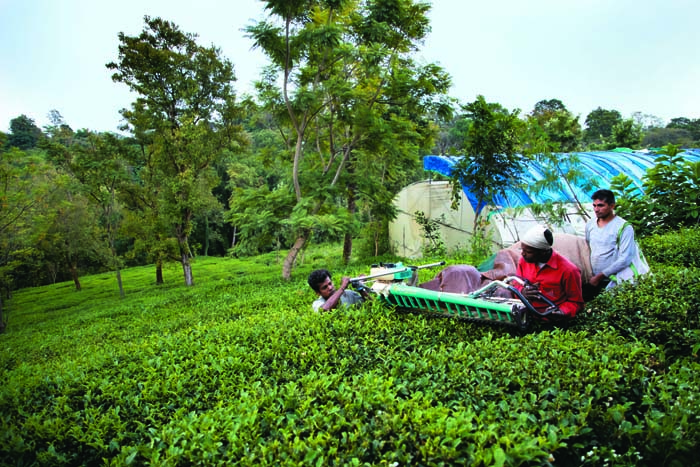
Different kinds of machines are available for plucking.Tea garden workers need to be trained to use them
In West Bengal, the Dooars specifically, the transformation began in the 1990s as more STGs emerged in the market. “They contribute to 48 per cent of the national tea production,” says Bijoy Gopal Chakraborty, President, Confederation of Indian Small Tea Growers’ Associations (CISTA). This represents more than 2.5 lakh STGs pan-India. On the district level, the work of different associations under CISTA is related to formation of clusters, SHGs, Farmer Producer Organisation (FPO) and all the other work involving policies and benefits.
Chakraborty elaborates, “In Jalpaiguri, better known as Dooars, there are 92 big estates and corporate tea gardens. And all are in harmony with more than 25,000 STGS. Around 79 SHGs/FPOs in cluster forms are working together.” But there were years when the differences did exist, until STGs came together.
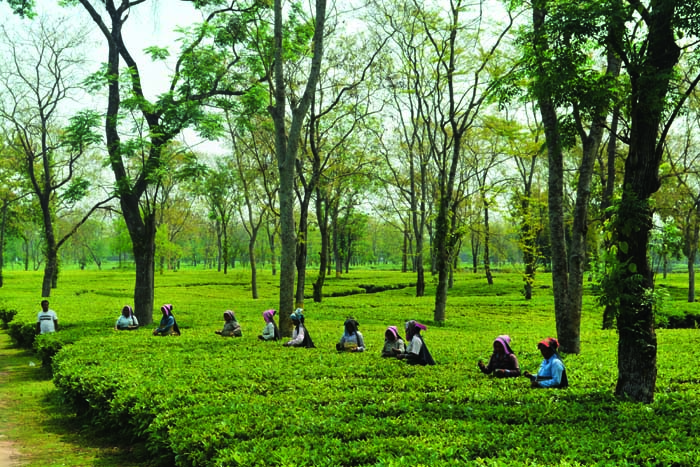
Workers in Damdim Tea Estate in the Dooars; (left) Himalayan Brew has some Brtitish era machines; women see to grading at the Wah Tea Estate, Palampur
“From 2004-2006, the STGs of North Bengal faced tough times as green leaf prices were down. In some areas, green tea leaves were thrown outside the factories. STGs felt controlled as bought leaf factories monopolised the eco-system. So, on June 1, 2006, 600 STGs from district Jalpaiguri called a convention on ‘STGs for Fair Price on Green Leaf’ at Zilla Parishad hall, Jalpaiguri, and an association with a 25-member executive committee was formed.” The face of the industry thus changed.
Between 2013-14, three STG clusters in the district established their own processing units. These clusters are Panbari, Jai Jalpesh and Nabajagaran STG Society. They have an annual production capacity of 6 lakh kg each of CTC tea. “These three groups pooled their own money, took financial aid from the Tea Board and a bank loan. They have cleared their bank loan of Rs 1 crore each.”
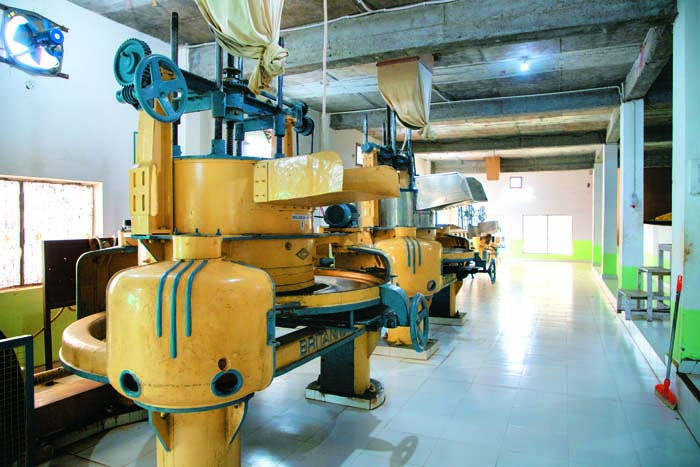
Harish Roy Chandra, who is a treasurer for the SHG running the Panbari factory, says, “We are a 300-member group. We got subsidies from the Tea Board and guidance by the district association. Around 20,000 kg of leaves come daily from the three villages of Panbari, Uttar Kalabasti, Chanmari. Not only good income, we also got good dividends. Our bank loan has been cleared and we have a FD of Rs 72 lakh in our account.”
The rise of STGs has resulted in manifold benefits. The growth of the tea industry has paved the path for many first-generation entrepreneurs. Even some of the new factories are run by those who believe in the ‘Make in India’ dream. Lifestyles have changed, as people are able to buy motorcycles and cars. Most of the farmers have sent their children to English-medium schools. And then there are intangible benefits like knowledge and training in new methods. The farmers have a new found self-confidence in their abilities.
Kangra Valley had almost 41,000 hectares of gardens during the colonial era. But now, the area has shrunk and the gardens lie abandoned. Most of these problems arose as people in the state opted for government jobs, families got smaller and the workforce depleted. However, the zonal office works on reviving abandoned gardens and supporting the major growers along with its other schemes to ensure the industry keeps moving.
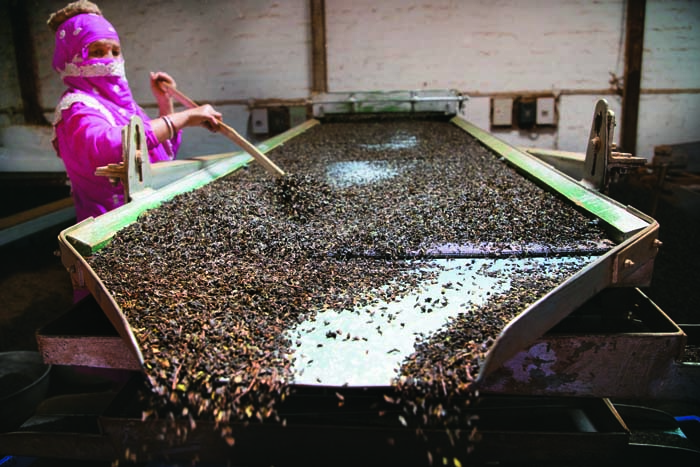
As for the road ahead, Jeevan Chandra Pande, Senior Manager, Danguajhar Tea Garden, Goodricke Group, says only quality is the key to prosperity. Goodricke is among the largest players in the country and buys from small growers too. “We are always willing to extend a helping hand to help farmers grow a better yield. Pricing fluctuates when the quality goes down. For our estate workers, we have an incentive system in place.”
The upsurge of STGs brought about a shift in their livelihood but evolving times demand more evolvement. Unique teas and inter -cropping during the lean winter months will change the game for these STGs in the coming times. Chakraborty says, “More than 10 lakh people are directly or indirectly benefiting from this industry. This silent green gold revolution has changed the face of the industry. Our target is to produce 50 lakh kg of CTC.”
Tea Board values the STGs as a very important component of the industry. As high as 64 per cent of the tea in Kangra comes from Small Tea Growers. Tea Board has given assistance of Rs 473.23 lakh to small growers from 2012 till September 2019. The zonal office in Palampur now has upgraded facilities such as Farmer’s Training Hall, Small Tea Growers’ Cell. There are special schemes for Himachal Pradesh. The Project Palampur R&D Scheme is being implemented soon for technology demonstration and quality improvement.
Kangra Valley had almost 41,000 hectares of gardens during the colonial era. But now, the area has shrunk and the gardens lie abandoned. Most of these problems arose as people in the state opted for government jobs, families got smaller and the workforce depleted. However, the zonal office works on reviving abandoned gardens and supporting the major growers along with its other schemes to ensure the industry keeps moving.
Among those who have worked on revival and inclusion is Rajiv Sud, Managing Director, Himalayan Brew, Palampur. The tea estate goes back to 1850, but the family had abandoned it. Sud was in the Singapore Army when he decided to come back and reclaim the legacy. “It wasn’t easy, as I had to learn the business and bring the estate to life. I slowly learned the ropes.
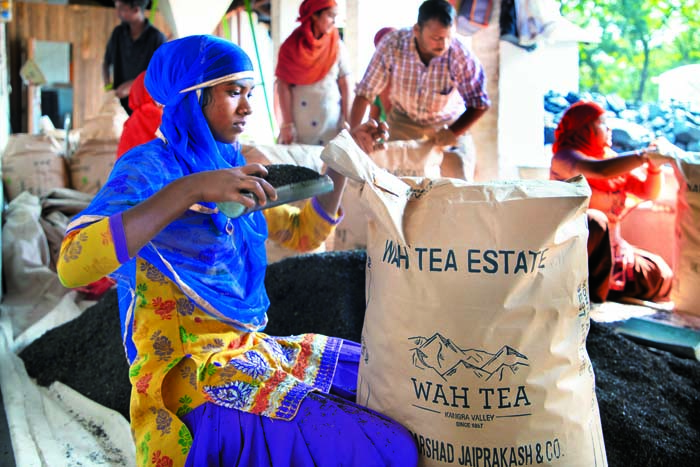
I had a passion for blending teas and did it all myself. I went around with a backpack to sell the packets initially. Then I participated with stalls in fairs, bought old machines and sold some, kept some. My model has always been inclusive, as I realised that this couldn’t be done otherwise. I have a bought-leaf factory. Besides my own gardens, I take leaves from 20 farmers. I pay them a good price as they bring the quality I need. We are the first tea garden to start mechanised plucking in this area. We have machines, shears and we also do hand plucking. Besides, my own 26 blends under Himalayan Brew, I also undertake tea bag packaging for others, the only garden in Kangra with this facility. We supply tea to JW Marriott, southeast Asia. It’s only 10 years down the line that I can say my decision has worked out well. Since, I am a marketing man, my wife, Richa, runs the factory.”
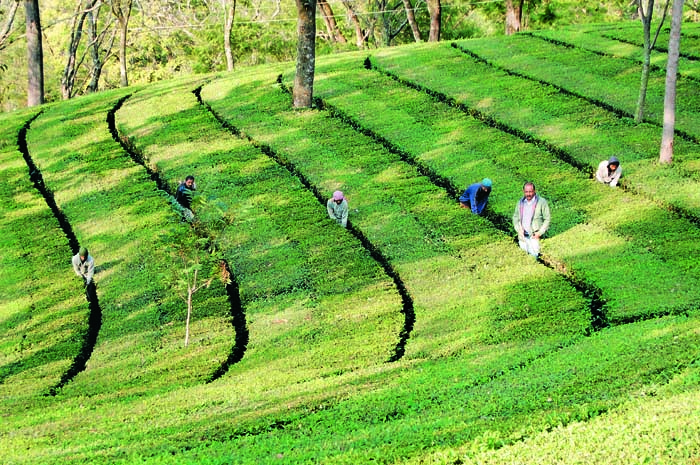
Old growers like Wah Tea Estate and Dharamshala Tea Company vouch for the quality that comes from Kangra. “As the area is pesticide and weedicide free, we get good orthodox, green and black tea,” says Surya Prakash, owner, Wah Tea Estate. Kangra tea is aromatic and has a unique flower-like fragrance. It is regular care that keeps the gardens lush. Dharamshala Tea Company has two certified organic gardens—Towa and Mann—and the “teas are exported to Germany, Netherlands and France”, says the manager Aman Pal Singh.
Supported by the Tea Board, STGs in the Nilgiris united to form the ‘Small Tea Producers Association of Nilgiris’ (SPANI) at Kotagiri. The lead was taken by C. Manogaran, a STG hailing from Batalada, a small hamlet in Kotagiri Taluk of the Nilgiris District. Much like a cottage industry, the leaves plucked by STGs are processed by their own and they can individually produce up to 5kg of handmade tea per day, fetching them around Rs 2,000 per day.
Sudanshu Sarkar, Secretary
Nutanbasti Pragatisheel Small Tea Growers’ Association
This STG focuses on quality for a better price and more yield.
"We have
training sessions by the Tea Board. Inter-cropping during lean months helps keep
the income steady. We also get pluckers on a need-be basis."
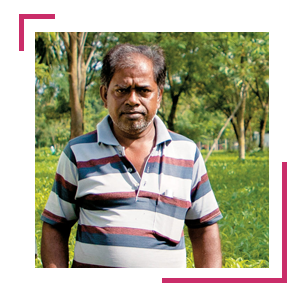
Manuj Mandhotra, PreSident
Green Gold Self Help Group, Palampur
Aid has helped him keep a century-old legacy alive.
"Tea Board keeps us
informed of the various schemes. We got vehicles and plucking machines at a
subsidised rate.
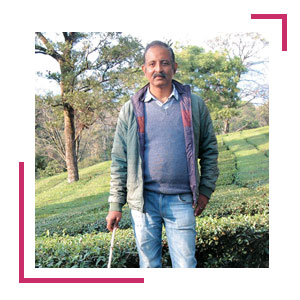
With a focus on creating experiences around tea, Tea Board is pushing the case for tea boutiques and branding. This is in sync with the government’s ‘Make in India’ and ‘Brand India’ schemes. The plan to open exclusive Indian tea boutiques across the world is on the roll.
Coming to the tea regions, in Jalpaiguri, Mission Hill Tea Estate has taken the lead and established a tea boutique on the highway leading to Guwahati and Bhutan. With a petrol pump and the only clean washroom in the vicinity for tourists, this offers snacks and speciality teas such as roasted, white, oolong and more. All the teas are manufactured in the Mission Hill estate only, nothing is sourced.
The STGs too are planning something similar, adds Chakraborty. In fact, Wah Tea Estate has plans to offer high-end tea-drinking experiences, “as we also have handcrafted teas”, adds Prakash. Sud is also exploring a tea boutique possibility in Shimla, which has a high tourist influx.
SHGs such as Green Gold Palampur also wish to have their own branded tea boutiques in areas like Bir Billing. President Manuj Mandhotra is keen that they develop a brand which will attract more people to Kangra tea. “We were very pleased when our Prime Minister presented Kangra tea, along with other specialty Indian teas such as Darjeeling, Assam and Nilgiri, to the US President in 2017. It is such a boost to our industry here. The production of tea in the state is nine lakh kg per annum. And we would like to have more retail and tourism related options.”
Mandhotra is among the few who have been carrying the legacy of tea growing from the last 100 years in Kangra. His grandfather bought the Mansindal Tea Estate from a Britisher in 1911. “This tea would initially be sent to Pakistan, Iran, Afghanistan. Now, we need more retail outlets too.”
Once the growers move from ‘the sack to the experience’, tea is bound to become a premium drink. The visionary Arun Kumar Ray, Deputy Chairman, Tea Board India, says, “STGs can align with the big growers to pick up the best practices. So the Tea Board focuses on FPOs and co-operatives that want to work on special teas. All good Chinese and Japanese teas sell for $2,000 onwards per kg, so all the growers have to be on the same platform to take India to those heights.”
In Assam, a Japanese expert team trained farmers to make matcha tea. With organic commanding higher prices, the need to grow good tea is higher. In Kangra, there is a plan to lend marketing support to the SHGs and FPOs by promoting tea through the state-owned HPMC, which is known for its apple juice, and also sale of speciality and ready-to-drink teas such as iced tea.
The Deputy Chairman has been dynamically moving cross-country and across the globe and brainstorming on taking the industry to new heights. The wheels are forever rolling for the leaves grow the year through. And Tea Board India is working 24X7 on its vision to make India Tea the most preferred beverage worldwide.

Arun Kumar Ray
Deputy Chairman,Tea Board India
How has digitalisation changed the industry?
Technology has helped us form a strong network and given us global accessibility. The Chai Sahyog app is the route to know the worth of the produce. All the registered growers now have all the information on their fingertips. We give them a QR code which helps with all transactions. We have also developed a machine which will do the fine leaf counting. The machine is being tested in 12 locations. In the first phase, it will be tested in Assam and West Bengal and then the second phase will be in the south. Then the price of green leaf will not be a contentious point anymore.
There is a perception that mechanisation reduces quality. Is that myth or fact?
Good tea is all about good leaves. If a farmer is properly trained, then mechanisation does not reduce the quality. Machines are being used all over the world for plucking leaves.
What other reforms are being carried out?
For the women, we are soon going to associate with a NGO for awareness sessions on work-life balance and healthcare. We are also going to sign a MoU with ILO and introduce the same international policies for the industry. For electronic auctions, we have partnered with mjunction. There will be a separate section for speciality tea manufacturers on this platform. With the reforms suggested by a strategy team at IIM Bengaluru, we are anticipating good results in terms of price realisation. Last year, we sold 510 million kg tea. This year, it has gone up to 580 million kg.
What is the way forward for STGs to flourish?
Good quality only! Plucking randomly is not going to fetch the right price. Go organic and focus on speciality teas. Certification through authorised agencies will give them the right credentials for profits.
What do you think the industry should focus on?
For old civilisations such as the Chinese, tea is a ceremonial experience. For us, it is a part of our lifestyle. We have to turn it into a culture. We have to make good tea, and pay that price for good tea even in the domestic market. Around 90 per cent of our tea is CTC which is generally consumed with milk. Only orthodox Darjeeling tea has been associated with culture but that’s because the British marketed it and took it to other countries. The Tea Board-supported boutique in Tokyo is a game changer. We also have GI certified teas—Assam Orthodox, Darjeeling, Nilgiri Orthodox and Kangra. We have to ensure the best goes into the global markets.




